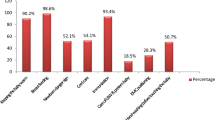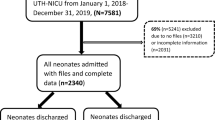Abstract
Objective:
Evaluate the impact of improved neonatal intensive care facilities on survival and referral patterns at a teaching hospital in Ghana.
Study Design:
Retrospective cohort comparing birth weight-specific survival and referral pattern of newborns requiring intensive care before and after improvement of facilities.
Result:
Improved survival of newborns <2500 g especially those 1000–1499 g (OR=1.74 (CI 1.38–2.20; P<0.00001) for inborn, OR=2.16 (CI 1.36–3.44; P=0.0006) for out-born). Birth asphyxia, the major indication for ⩾2500 g newborn referrals, was associated with reduced survival (OR=0.56 (95% CI 0.40 to 0.78; P=0.0004)). There was fourfold increased referral of out-born ⩾2500 g.
Conclusion:
Improved facilities significantly improved survival of newborns <2500 g, but was of no benefit for newborns ⩾2500 g. A scaling-up approach with investments that improve emergency obstetric services, referral systems, human resources and neonatal resuscitation practices will save more newborn lives.
This is a preview of subscription content, access via your institution
Access options
Subscribe to this journal
Receive 12 print issues and online access
$259.00 per year
only $21.58 per issue
Buy this article
- Purchase on Springer Link
- Instant access to full article PDF
Prices may be subject to local taxes which are calculated during checkout
Similar content being viewed by others
References
Saving Newborn Lives. State of the World's Newborns. Save the Children-USA: Washington, DC, 2001.
Hyder A, Morrow R, Wali S, McGuckin J . Burden of Disease for Neonatal Mortality in South Asia and Sub-Saharan Africa. Save the Children Federation-USA: Washington, DC, 2001.
World Health Organization. Pregnancy, Childbirth, Postpartum and Newborn Care: A Guide for Essential Practice. World Health Organization: Geneva, Switzerland, 2003.
Jones G, Steketee RW, Black RE, Bhutta ZA, Morris SS . How many child deaths can we prevent this year? The Bellagio Child Survival Study Group. Lancet 2003; 362: 65–71.
Knippenberg R, Lawn JE, Darmstadt GL, Begkoyian G, Fogstad H, Walelign N et al. Lancet Neonatal Survival Steering Team. Systemic scaling up of neonatal care in countries. Lancet 2005; 365 (9464): 1087–1098.
Karlsen KA . The S.T.A.B.L.E. Program 2001 Edition.
American Academy of Pediatrics Committee on Fetus and Newborn, American Heart Association Sub-committee on Pediatric Resuscitation, International Liason Committee on Resuscitation Pediatric working group et al. Neonatal Resuscitation Textbook, 4th Edition. United States of America: American Academy of Pediatrics and American Heart Association 2000.
Kattwinkel J, Cook LJ, Hurt H, Short JG, Nowacek GA . Perinatal Continuing Education Program University of Virginia Patent Foundation 2004.
World Health Organization: International Statistical Classification of Diseases. WHO/DIMDI 1994/2006 Chapter XVI, P21.0, P21.1.
Pieper CH, Smith J, Kirsten GF, Malan P . The transport of neonates to an intensive care unit. S Afr Med J 1994; 84 (11 Suppl): 801–803.
Lodé N, Chabernaud JL, Chouakri O, Casadevall I, Maury I, Lagrue E et al. Newborn asphyxia at term during delivery. J Gynecol Obstet Biol Reprod 2003; 32 (Suppl): 1S98–1105.
Callaghan LA, Cartwright DW, O’Rourke P, Davies MW . Infant to staff ratio and risk of mortality in very low birth weight infants. Arch Dis Child Fetal Neonatal Ed 2003; 88: F94–F97.
International Neonatal Network, Scottish Neonatal Consultants, Nurses Collaborative Study Group. Risk adjusted and population based studies of the outcome for high risk infants in Scotland and Australia. Arch Dis Child Fetal Neonatal Ed 2000; 82: F118–F123.
Were FN, Mukhwana BO, Musoke RN . Neonatal survival of infants less than 2000 g at Kenyatta National Hospital. East Afr Med J 2002; 79 (2): 77–79.
Velaphi SC, Mokhachane M, Mphahlele RM, Beckh-Arnold E, Kuwanda ML, Cooper PA . Survival of very-low-birth-weight infants according to birth weight and gestational age in a public hospital. S Afr Med J 2005; 95 (7): 504–509.
Fanaroff AA, Wright LL, Stevenson DK, Shankaran S, Donovan EF, Ehrenkranz RA et al. Very low birth weight outcomes of the National Institute of Child Health and Human Development Neonatal Research Network, May 1991 through December 1992. Am J Obstet Gynecol 1995; 173 (5): 1423–1431.
Owa JA, Osinaike AI . Neonatal morbidity and mortality in Nigeria. Indian J Pediatr 1998; 65 (3): 441–449.
Kinoti SN . Asphyxia of the newborn in east, central and southern Africa. East Afr Med J 1993; 70 (7): 422–433.
Haider BA, Bhutta ZA . Birth asphyxia in developing countries: Current status and public health implications. Curr Probl Pediatr Adolesc Health Care 2006; 36: 178–188.
Bang AT, Bang RA, Baitule S, Deshmukh M, Reddy MH . Burden of morbidities and the unmet need for health care in rural neonates—a prospective observational study in Gadchiroli, India. Indian Pediatr 2001; 38: 952–965.
Acknowledgements
The authors reviewed the statistics and received no financial support for this work.
Author information
Authors and Affiliations
Corresponding author
Rights and permissions
About this article
Cite this article
Enweronu-Laryea, C., Nkyekyer, K. & Rodrigues, O. The impact of improved neonatal intensive care facilities on referral pattern and outcome at a teaching hospital in Ghana. J Perinatol 28, 561–565 (2008). https://doi.org/10.1038/jp.2008.61
Received:
Revised:
Accepted:
Published:
Issue Date:
DOI: https://doi.org/10.1038/jp.2008.61
Keywords
This article is cited by
-
Implementation of a referral and expert advice call Center for Maternal and Newborn Care in the resource constrained health system context of the Greater Accra region of Ghana
BMC Pregnancy and Childbirth (2021)
-
Improved referral and survival of newborns after scaling up of intensive care in Suriname
BMC Pediatrics (2017)
-
Does facility-based newborn care improve neonatal outcomes? A review of evidence
Indian Pediatrics (2012)
-
Challenges in scaling up of special care newborn units-lessons from India
Indian Pediatrics (2011)
-
Global report on preterm birth and stillbirth (3 of 7): evidence for effectiveness of interventions
BMC Pregnancy and Childbirth (2010)



